All About Faux Fur

Faux fur is a fabric made from fine, extruded pieces of plastic attached to a backing. It is far cheaper than real fur and harms no animals in its production.
Not all faux fur is made the same, and not all faux furs are used for the same purpose! For example, some furs look beautiful when kept at their original length, but look sparse and patchy when shaved down. On the contrary, some furs look smooth and flawless when shaved. Learning to recognize furs and their traits is a skill picked up over time and with experience.
This is an extensive guide; you don't need to read everything here. Some of the more advanced/technical topics such as laser cutting are meant to be a brief overview/introduction.
Table of Contents:
Faux Fur Field GuideMost Popular Types: Other Short: Other Long: Specialty: Where to Buy Fur Online
Shopping in Person (Local Finds)
Price vs Quality
When do I know I can shave my faux fur?
Acrylic vs Polyester Furs
Fur Alternatives
Dye Sublimating Faux Fur
Laser Cutting Faux Fur
Faux Fur History
Attributes
Field Guide
Most Popular Types:
Luxury Shag

(aka Ecoshag, or just shag)
Length: 1.5-2 inches (3.8-5.1 cm)
Texture: Soft
Notes: The most commonly seen and widely available type of fur. It's pretty standard and has a luxurious feel. It has a bit of a sheen to it. Sometimes it shaves well, sometimes it doesn't. It all depends on the lot and the manufacturer. I've found that luxury shag from Howl Fabrics tends to shave better than Big Z Fabric's Ecoshag. Most luxury shag furs are uniform; all the fibers are the same color and length.
Deluxe Fox
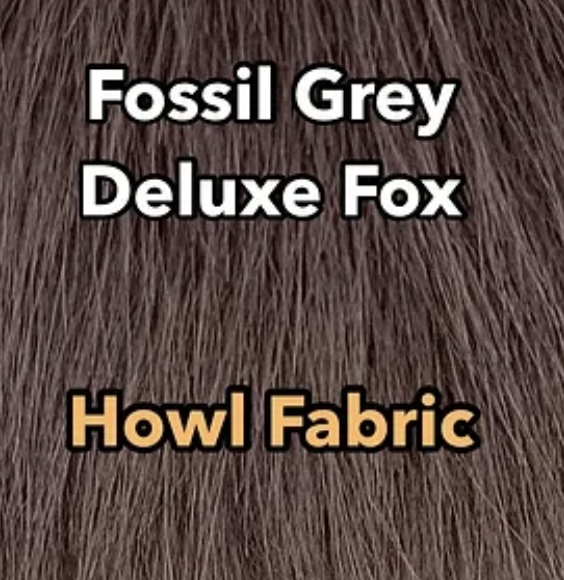
Length: 2.25-2.5 inches (5.7-6.3 cm)
Texture: Coarser than shag. This isn't a bad thing! It's coarser in a "closer to a real animal's fur" way, rather than an artificial coarseness.
Notes: A longer and more realistic type of fur that is most commonly offered in natural colors. Features lighter guard hairs that provide more texture. Tends to lay flat instead of "clumping" like shag. Shaves really well.
Luxury Teddy

Length: 1 inch (2.5 cm)
Texture: Soft, with a coarseness between luxury shag and deluxe fox
Notes: A fan favorite amongst fursuit makers. Shorter than shag, denser than shag, shaves beautifully, and lays flatter than shag.
Beaver
 (aka super seal)
(aka super seal)Length: 0.5 inches (1.3 cm)
Texture: very soft
Notes: Very short and has a more prominent sheen compared to other furs. Commonly used for handpaw fingers or anywhere else that needs very short fur. Available in a variety of colors. Its density makes it super easy to shave.
Other Short:
Teddy Fox
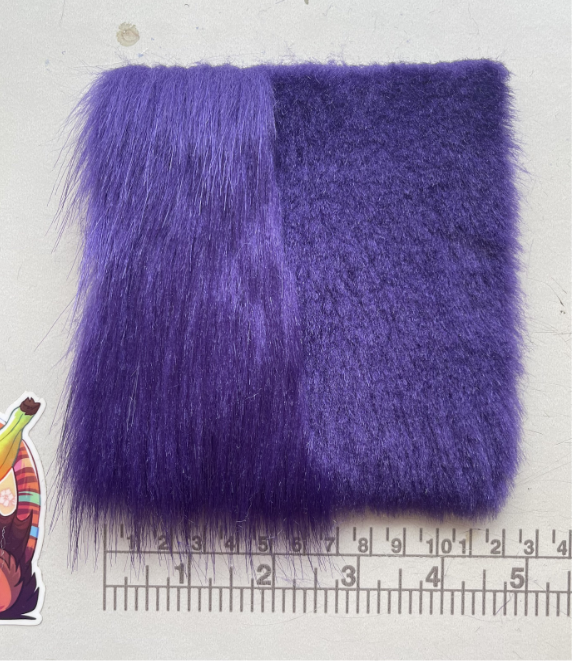
Length: 1 inch (2.5 cm)
Texture: Soft, with a coarseness between luxury shag and deluxe fox
Notes: A wonderful dense hybrid between luxury teddy and deluxe fox. Has the length and texture of teddy, but with the guard hairs of fox. Shaves beautifully, no white patches in the backing, and has a lovely sheen. Only sold by Canfur at the moment.
Luxury Bear
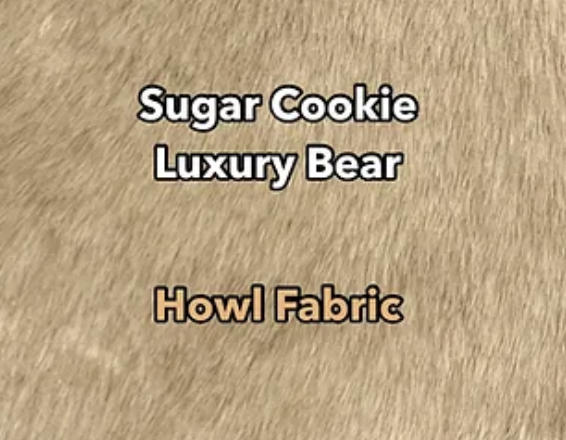
Length: 0.5 inches (1.3 cm)
Texture: Similar texture to teddy
Notes: A shorter version of teddy that Howl offers. Does not come in many colors yet, I believe this is supposed to be a replacement for a discontinued Monterey Mills fur.
Bunny
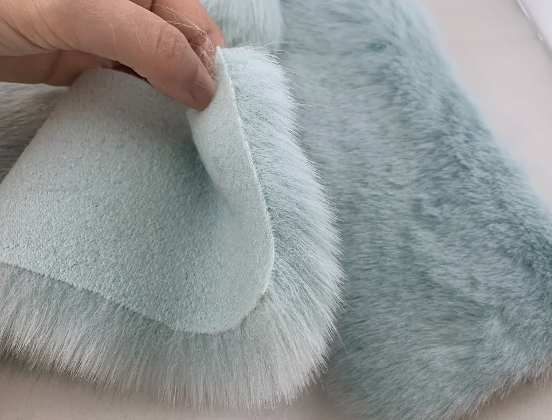
Length: 1 inch (2.5 cm)
Texture: Softness between luxury shag and beaver
Notes: Very soft, creases easily. Shaves wonderfully.
Polymink
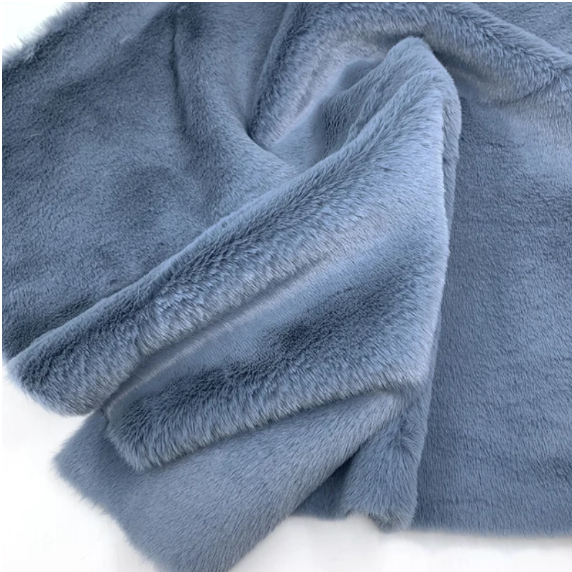
Length: Varies (tends to be very short)
Texture: Very soft!
Notes: This is a short polyester-based fur that can be dye sublimated on. Fursuitsupplies carries a type called Chinchilla, but I'm not sure if it's the same. I ordered mine off Aliexpress. It shaves well because of its density, but it's already short enough for faces. Stretches a little.
Other Longer:
Monster
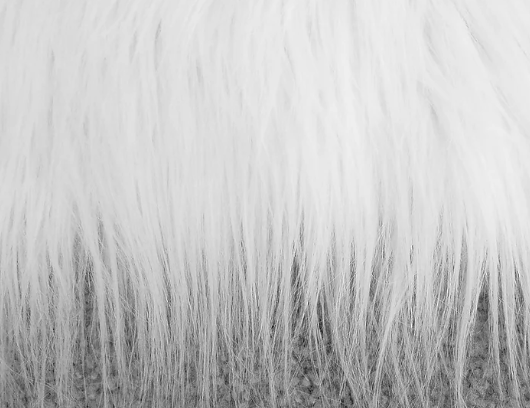
Length: 4 inches (10 cm)
Texture: Long and silky
Notes: Great fur for long areas, such as manes, hair, or accents! Not meant to be shaved. Very high quality.
NFTech
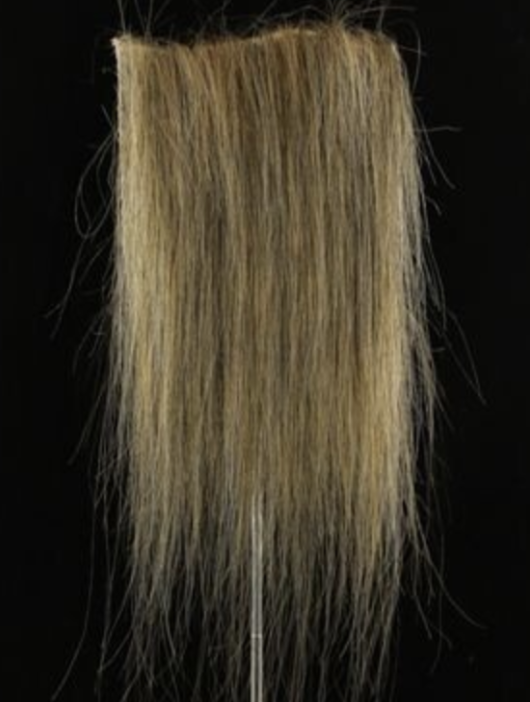
Length: Varies
Texture: Varies
Notes: Extremely high quality stretch fur, produced by National Fiber Technology. Many of their furs are used for high-end productions such as Hollywood films. Commonly used for hair, but can be used anywhere. The quality comes at a price, NFTech fur is very expensive.
Gorilla
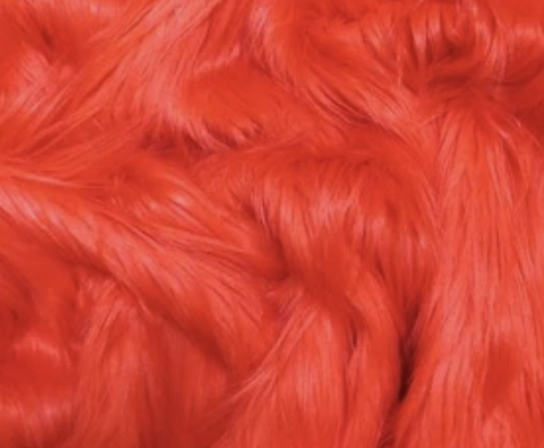
Length: 4 inches (10 cm)
Texture: Thinner and a little coarser than shag
Notes: Thinner version of monster. If you can get yardage of monster I'd recommend it over this, but can be used in a pinch. It comes in more colors than monster. Tends to clump a little, but looks fine when brushed. Also not meant to be shaved.
Specialty:
Mongolian
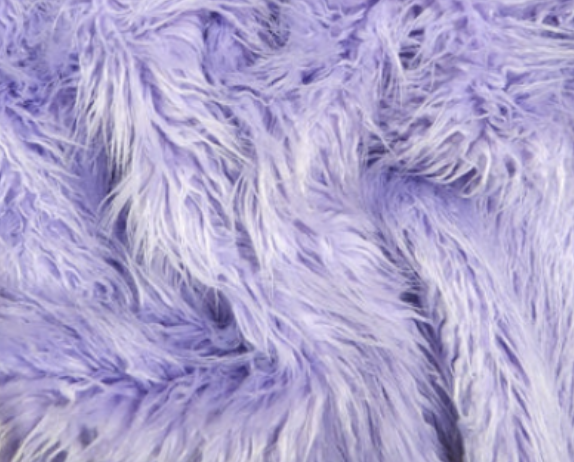
Length: 3 in (7.6 cm)
Texture: Intentionally rough and curly
Notes: This fur is sometimes mistaken for being matted, even though its appearance is intentional. It can be uncurled to resemble something adjacent to luxury shag if it comes in a color you need. I don't see it used as often as it used to.
Spiked

(aka 3-toned)
Length: 1.5 inches (3.8 cm)
Texture: similar to shag
Notes: A dual-length fur that is mostly short apart from some spikes of longer fur.
Tinsel
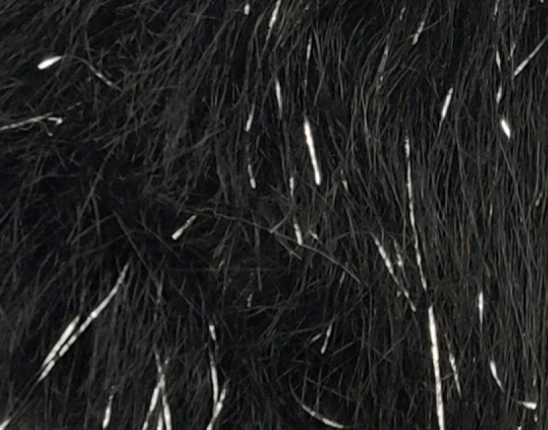
(aka sparkle fur)
Length: Varies, but tends to be on the longer side (3+ inches; 7.6+ cm)
Texture: Coarser than shag, with rougher bits of tinsel throughout
Notes: Commonly seen as shag with bits of tinsel in it. You probably shouldn't shave this!
Where to buy fur online
Check the more resources page for a list of faux fur producers!I also have my fur color picker to assist in finding color matches. It only includes a few faux fur suppliers, but it can still simplify the process greatly.
Keep in mind that even if you have a high-end and color-accurate display, nothing can replace feeling and seeing the fur in person. Be sure to get various swatches you think might be correct before committing to the full amount you need in your project.
Some makers prefer skipping the middleman and purchasing directly from manufacturers on sites such as Alibaba or Aliexpress. If you know what to look for and have hands-on experience with it, I'd say go for it! Otherwise, especially if you're new, try to stick to known and reputable suppliers (such as the ones featured on the list).
What about shopping in person?
The term "local find" refers to high-quality faux fur found locally at a brick-and-mortar store.If you're unfamiliar with faux fur and you'd like to purchase your fur in person, I still recommend getting swatches of luxury shag and deluxe fox to familiarize yourself with high quality fur's texture and appearance. Alternatively, if you already have a fursuit part that you know is made from a known high-quality faux fur (or take an up-close look at a friend's), you can use that instead of a swatch.
Pay attention to the texture of the fur: luxury shag is soft to the touch and dense, making it difficult to see the backing when you part the fibers. The backing itself should be woven on a longer fur, though if the fur is shorter it can l either be a woven backing (preferred), or a knit backing (softer and slippery). If it has a knit backing, there is a chance it is a polyester fur!

At a store, feel the fur you are interested in purchasing and check the backing. If the fur is coarse, has a scratchy backing, and you can easily see the backing by parting the fibers a little, it is likely "fun fur". Fun fur is not as dense as higher quality furs and sheds a lot easier than other types of fur. I strongly recommend using a higher quality fur than fun fur, even if it is more expensive.
Price vs Quality
It may be tempting to save a few extra dollars and purchase fun fur or whatever is simply the cheapest on Amazon. I fell into that pitfall when I started making fursuits. I even tried making an all-minky fursuit for my third suit because I thought I could save some money. The results are very hit or miss, leaving you with a fur that is very hard to work with and of subpar quality.Some in-person stores like Joann Fabrics charge double what you can find online for fur such as luxury shag. They often run sales (I've gotten some great quality fur from them for a discount), but being aware of both fur prices and fur quality can help you make an informed decision.
When do I know when I can shave?
Most of the faux furs I've listed in the field guide can be shaved, with some exceptions I have pointed out. If you're buying from a new site or in person, the best way to know is to get a swatch or two and try shaving it yourself.Here's an example with a swatch of gorilla fur and luxury shag fur, given to me by my friend Rayfoxyote:
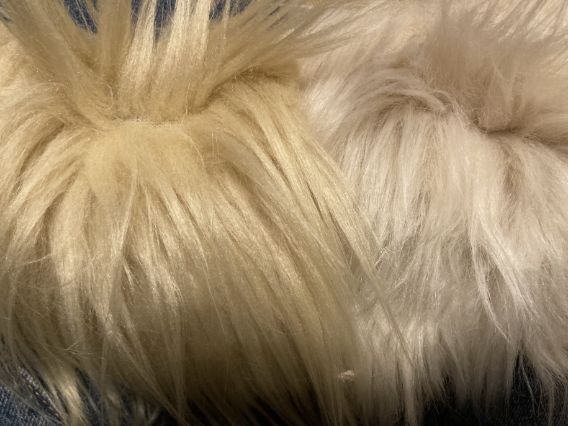
Pictured left is a gorilla fur swatch, and the right is a luxury shag swatch with their fabrics parted to accentuate the gorilla fur's sparsity.
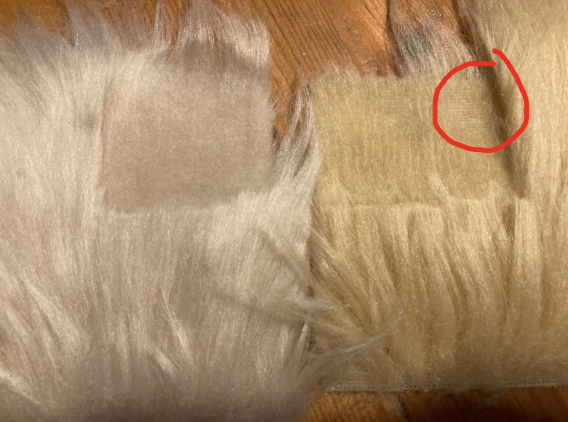
I shaved both pieces with approximately the same pressure and time (under a minute; just a quick shave). The luxury shag resulted in a far better shave than the gorilla fur, which ended up shaving to the backing. I circled the bald spot in the photo above.
You can perform the same test with your own mystery swatches of fur to gauge well it would shave. I would be fine with using gorilla at its full length, it would make for some fun longer accents on a bodysuit. However, I would opt for a different fur if I wanted to shave it down for a face, handpaw digits, or footpaw toes.
Acrylic vs Polyester Furs
Most furs in my field guide are made of acrylic, but certain furs (such as polymink) are made of polyester. These furs tend to be shorter than their acrylic counterparts, making them great for soft plush toys.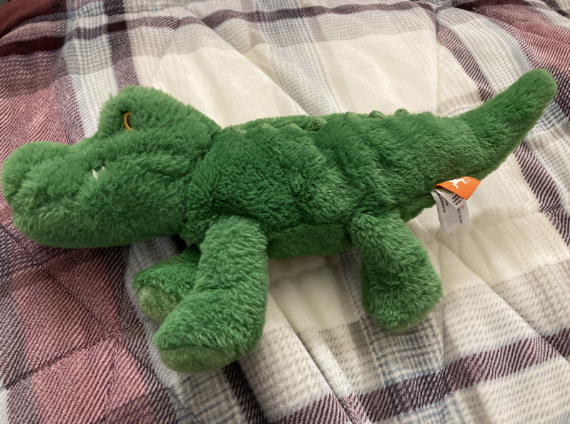
(a gator plush made from polyester fur)
In 2021, Shannon Fabrics stopped regularly offering their luxury shag line in favor of a 100% polyester line called "dreamy fur". The fibers appear to be very thin but clump together more. I don't own any swatches of it so I can't say how it looks brushed. I prefer the look of Shannon's luxury shag over this.
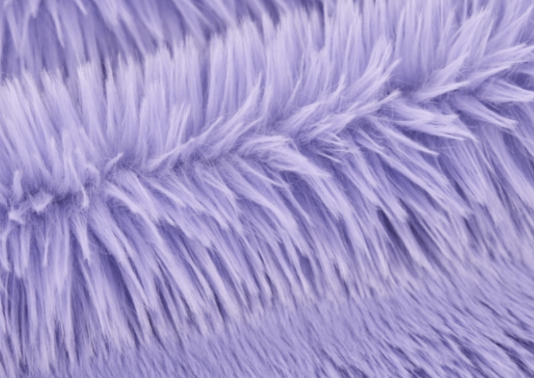
Fur Alternatives
Despite the name, you don't have to use fur for a fursuit!Some makers make non-fur materials look incredible on a fursuit. Think fleece, minky, burlap, brushed out yarn, needlefelted wool, rubber, latex, paper, the list goes on.
If you would like to use a material that isn't fur, be sure you know what you're doing! Fur is relatively forgiving, some of the other materials listed can be difficult to work with. This is a "try at your own risk" decision. If done right, you can create a very unique looking fursuit with a fur alternative. However, I recommend experimenting and testing with your chosen material before committing it to a large project such as a fursuit.
I mentioned in a different section of this article that I tried making an all-minky fursuit for my third suit. I had failed and never finished it. If I had grown more comfortable with minky and understood its quirks (and had a stronger grasp on fursuit making as a whole), perhaps I would have been more successful.
Dye Sublimating Faux Fur?
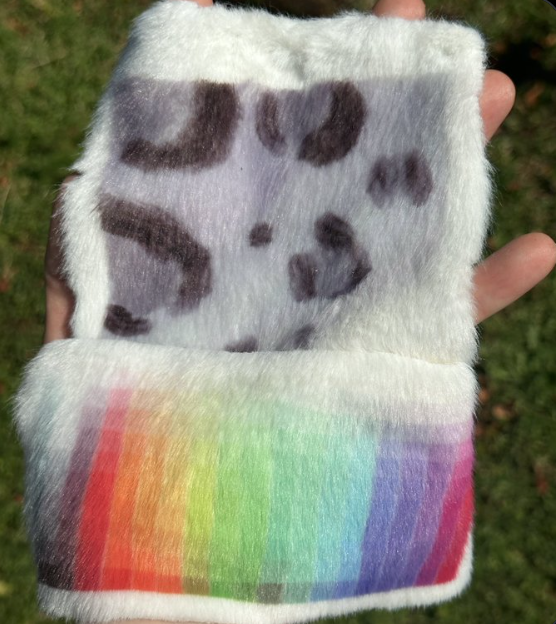
(photo/work credit: Mantacraft Studios)
Polyester has a much higher melting point than acrylic, which means it can be dye sublimated! Dye sublimation is a process that transforms a solid directly into a gas, completely bypassing the liquid phase. When the gas hits an object, it turns back into a solid and embeds itself into the material. Many graphic t-shirts utilize dye sublimation because it is easy to create many different designs with it, and the prints are long-lasting.
You may want to consider dye sublimating polymink if your character has gradients on their face or tiny markings, such as freckles. Sewing many small markings can be tedious, difficult, and have small margins of error. Dye sublimated markings are strong and crisp. The only downside is that it may not hit all of the undercoat fur fibers, meaning it may show the original fur's color if the fibers are parted enough.
If you're looking to dye a piece of polyester fur one uniform color, you can avoid this issue by dyeing it regularly instead of with dye sublimation. The dye will affect the entire piece.
Laser cutting fur?
Faux fur can be laser cut, but only with the proper tools and ventilation!The modacrylic fibers that make up faux fur can release cancer-causing fumes when heated up too much. Laser cutting fur can be a huge time saver, but must be done safely and with plenty of ventilation. Do your research and plan accordingly to ensure your safety. You must have a proper ventilation system with filters to avoid getting sick.
Faux Fur History
Faux fur was first created in the early 20th century and was originally made from alpaca hair. During World War I, the US government enforced a 10% tax on real animal fur, which led to an increase in faux fur sales. In the 1950s, the faux fur industry rapidly switched from the original alpaca hair to extruded acrylic plastic. With this quality boost, faux fur has been on the rise ever since, with many animal rights groups advocating for its use in the fashion industry instead of real fur.In 1965, US-based paint roller fabric manufacturer Monterey Mills began producing faux fur. Monterey Mills created fur for the fashion industry, toys, mascots, and animatronics. Many US-based fabric stores stocked their furs, and at a time where online ordering was limited, the first fursuit makers could only purchase their furs in person at these stores. Many older fursuits were made with Monterey Mills fur, it was regarded to be high quality. Monterey Mills has seemingly discontinued their faux fur line, with Wayback Machine pages mentioning their faux fur ceasing at the end of 2018. CR's Crafts still seems to offer some of their remaining stock.
Shannon Fabrics was founded in 1995 and began wholesale manufacturing of faux fur, most notably luxury shag, in the 2000s. In fursuit making circles, luxury shag used to commonly be referred to as "DF fur", because Distinctive Fabrics was the first supplier to garner attention from fursuit makers at the time. Other suppliers carried Shannon's luxury shag under different names. Mendels called it "punky muppet", some sites called it "promo shag". Distinctive fabrics has also shut down their store. Shannon Fabrics stopped stocking luxury shag in 2021, citing materials and shipping costs.
Despite many of the original faux fur suppliers being nonexistent nowadays, many have taken their place, including furries within the community! Fursuitsupplies.com was founded in 2012, Howl Fabrics was launched in 2018, and Canfur opened in 2020. These are all faux fur businesses by fursuit makers, for fursuit makers. Big Z Fabric began manufacturing their own Ecoshag line in 2018, but has been offering faux fur since before they even had an online website.
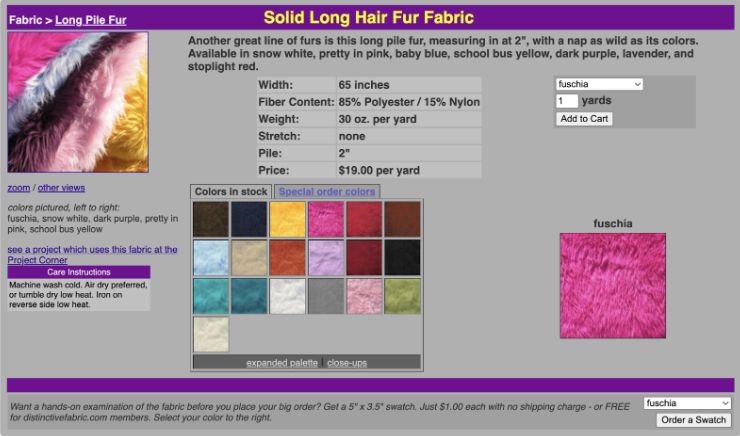
Above is an archived screenshot from 2006 of Distinctive Fabric's long pile faux fur listing. Colors were very limited, and many colors that are standard today didn't exist (such as dark gray). We now have hundreds of colors in varying lengths, textures, and styles. Companies such as Big Z Fabrics have heavily expanded their faux fur line in response to fursuit makers becoming a staple in their sales. With the strong growth of the furry fandom since the turn of the decade, and the uptick in fursuit makers as a result, I am looking forward to seeing how the faux fur industry evolves :)
Attributes
https://www.smithsonianmag.com/history/history-faux-fur-180953984/https://ko-fi.com/post/What-is-Polymink-U7U3U8BZZ
https://www.shannonfabrics.com/
https://fursuit.livejournal.com/5049516.html?view=comments#comments
https://en.wikipedia.org/wiki/Fake_fur
Thank you to my friend Xavier/Prectriv for editing!
Teddy Fox photos courtesy of Frouzon, owner of Thread's Workshop
Back to top
